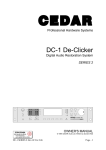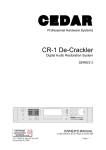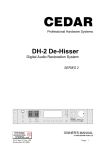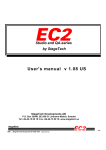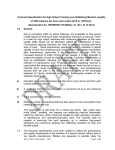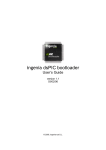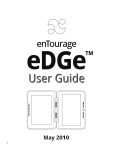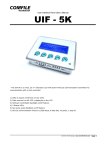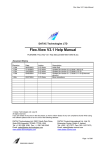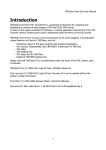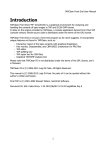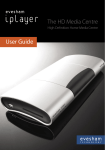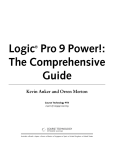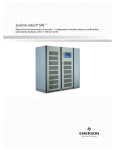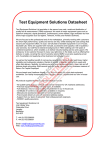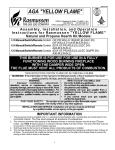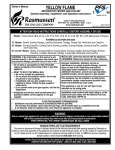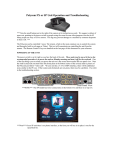Download Series 2
Transcript
CEDAR
Professional Hardware Systems
AZ-1
Azimuth Corrector
Digital Audio Restoration System
SERIES 2
Digital
Over
Power
Over
0dB
0dB
-10
-10
-20
-20
-40
48kHz
4
0
Input Level
8
10
12
Output Attenuation
Page
Pre/Post
Enter
Pre
Post
6
2
Bypass
Bypass
-40
Level
Phones
44.1kHz
CEDAR
CEDAR Audio Ltd
A member of the
Association of Professional Recording Services
Contrast
Azimuth Corrector AZ 1
SERIES 2
OWNER'S MANUAL
© 1994 CEDAR Audio Ltd. Written by Gordon Reid
AZ-1: Rev.02 Ver.1.15
November 30, 2005
Page - 1
TABLE OF CONTENTS
INTRODUCTION .........................................................................................................................................................3
THE BACKGROUND TO AZIMUTH CORRECTION .........................................................................................4
SAFETY INSTRUCTIONS........................................................................................................................................5
SET UP .........................................................................................................................................................................7
CONNECTIONS..........................................................................................................................................................8
SAMPLE INSTALLATION IDEAS .........................................................................................................................11
A GUIDE TO RESTORATION PROCESSING ..................................................................................................12
LOCATION AND FUNCTION OF FRONT PANEL INDICATORS AND CONTROLS ..............................14
QUICK TOUR ............................................................................................................................................................16
WARMSTART AND COLDSTART .......................................................................................................................17
OPERATING THE CEDAR AZ-1 ..........................................................................................................................18
PAGES ...................................................................................................................................................................20
Control Page ....................................................................................................................................................21
XY Display ........................................................................................................................................................26
Input/Output Control Page ............................................................................................................................27
Remote Control ...............................................................................................................................................31
STATUS PAGE ...............................................................................................................................................32
STATUS INDICATORS .................................................................................................................................32
TUTORIAL ..................................................................................................................................................................35
REMOTE CONTROL PROTOCOLS....................................................................................................................37
SELF TEST MODE...................................................................................................................................................40
AZ-1: Rev.02 Ver.1.15
November 30, 2005
Page - 2
INTRODUCTION
Thank you for purchasing the CEDAR AZ-1 Azimuth Corrector. This is the world's
most advanced dedicated phase/time correction device, and offers processing
power and performance that could only previously be obtained using digital signal
processors (DSPs) installed in desk-top (or larger) computer systems such as the
CEDAR Production System. The Azimuth Corrector is designed for professional use,
although it will work perfectly well in a domestic environment, and its features
include the following:
•
Real-Time Correction accurate to 1/20 sample.
•
Real-Time Detection accurate to 1/4 sample.
•
Real-Time Auto-Correction.
•
The latest 'SERIES-2' CEDAR hardware.
•
Digital Audio interfaces conforming to the AES/EBU and SP-DIF standards.
•
24-bit input and output resolution when using AES/EBU interfaces
•
Three sample rates supported on digital inputs: 32kHz, 44.1kHz and 48kHz
•
Two sample rates supported on analogue inputs: 44.1kHz and 48kHz
•
Balanced analogue inputs and outputs for connection to professional
analogue equipment.
•
ADC and DAC converters using the latest 64x over-sampling ∆-∑ (DeltaSigma) technology.
•
>103dB dynamic range A/D and >93dB dynamic range D/A
•
Mountable in a 19" EIA rack.
•
Remote control via MIDI and RS232 interfaces.
•
SMPTE/EBU timecode capabilities via optional upgrade
•
Input and output LED bar-graph VU meters.
•
Twin 40-bit floating point DSP processors delivering 50MFlops to handle the
most complex audio processing requirements.
•
High levels of artificial intelligence designed into the AZ-1 program algorithms
making it extremely simple to use.
AZ-1: Rev.02 Ver.1.15
November 30, 2005
Page - 3
THE BACKGROUND TO AZIMUTH CORRECTION
Phase problems and time delays between the left and right channels of a stereo
signal account for many of the problems suffered by the audio and video industries.
Typical consequences of these errors include poor mono compatibility, poor stereo
imaging, loss of high frequencies, and muddy bass response.
Audio technicians often employ a range of processors to hide these deficiencies:
equalisers, stereo enhancers, dynamics processors and reverb units. However,
none of these attack the heart of the problem - the small but significant nonsynchronisation of the left and right channels.
On the basis that, if you remove the cause of the problem the symptoms also
disappear, the CEDAR AZ-1 offers timing correction accurate to 1/20th of a sample,
enabling you to recover high frequencies and restore imaging that cannot be
corrected by other methods. Combining all the facilities of a phase Detector and
Corrector, the AZ-1 also features an AUTOTRACKING facility. This enables the unit
to measure the delay between the channels and use this value to compensate
automatically, in Real-Time, for the delay it detects. This delay is re-calculated 44
times every second, enabling the AZ-1 to compensate for rapidly varying timing
errors as well as constant differences.
Since the causes of phase/time errors also often lead to volume imbalances in the
stereo signal, the latest and most powerful CEDAR SERIES-2 DSP hardware also
features real-time monitoring with gain controls for precise balancing of the corrected
signal.
The operation of the AZ-1 is totally digital, and any signal presented to the analogue
inputs is converted internally to a suitable digital format by the high quality analogueto-digital converters (ADCs). Following Time Correction the processed signal is then
converted back from digital to analogue by the internal digital-to-analogue converters
(DACs).
For use with records, films, video, and tape, no other device offers the power,
facilities, or accuracy of the AZ-1.
AZ-1: Rev.02 Ver.1.15
November 30, 2005
Page - 4
SAFETY INSTRUCTIONS
CAUTION:
1.
Read all of these instructions
All safety and operating instructions should be read before the AZ-1 is
operated.
2.
Save these instructions for future reference.
3.
Follow all warnings and instructions.
4.
Water and Moisture
The AZ-1 should not be used near water, and must not be exposed to rain or
moisture. If the AZ-1 is brought directly from a cold environment into a warm
one, moisture may condense inside the unit. This, in itself, will not damage
the AZ-1, but may cause hazardous electrical shorting to occur. This could
severely damage the AZ-1, and even cause danger to life. ALWAYS allow
time for the AZ-1 to naturally reach ambient temperatures before connecting
the mains power.
5.
Mounting
The AZ-1 should be carefully mounted in a 19" EIA rack, or placed on a flat,
stable surface. If used on a cart or free stand, care should be taken when
moved: uneven surfaces or excessive force may cause cart and AZ-1 to
overturn. Do not position the AZ-1 in a place subject to strong sunlight,
excessive dust, mechanical vibration or periodic shocks.
6.
Wall or Ceiling Mounting
The AZ-1 has not been designed for mounting directly to walls or ceilings.
7.
Ventilation
Good air circulation is essential to prevent internal heat built-up within the AZ1. The AZ-1 should be situated so that its position does not interfere with
proper ventilation. The AZ-1 should not be placed in any situation which
impedes the flow of air through the vents at the front and rear. Do not place
the AZ-1 on a soft surface.
8.
External Heat Sources
The AZ-1 should be installed away from significant heat sources such as
radiators, and (if possible) away from other audio devices such as amplifiers
that produce large amounts of heat. Installation in racks with devices such as
signal processors or tape machines should not be a problem.
9.
Power Sources
The AZ-1 features an auto-switching power supply which will work safely on
any mains supply in the ranges 95v/130v and 190v/260v, 50Hz or 60Hz AC
only.
AZ-1: Rev.02 Ver.1.15
November 30, 2005
Page - 5
You should never attempt to modify or adjust the internal power supply
in any way. It contains no user serviceable parts.
10.
Grounding or Polarisation
The AZ-1 should always be grounded (or 'earthed').
11.
Power Cord Protection
Power connectors should be routed so that they will not be walked on or
pinched.
12.
Extended Periods of Non-Use
The AZ-1 is not disconnected from the mains power as long as it is connected
to the wall outlet, even if the unit itself has been switched off. Therefore, if the
AZ-1 is not to be used for an extended period of time, unplug the unit from the
wall. Pull the connector out by the plug, never by the cord itself.
13.
Cleaning
Clean only with a dry cloth. NEVER use liquid cleaners such as alcohol or
benzene on the AZ-1. NEVER use abrasive pads on the AZ-1.
14.
Damage Requiring Service
The AZ-1 should be returned to qualified service personnel when:
•
objects have fallen into the unit
•
liquid has been spilled into the unit
•
the unit has been exposed to rain
•
the unit fails to function or appears to operate abnormally
•
the unit has been dropped, or the case damaged.
15.
Servicing
The user should not attempt to service the AZ-1 beyond the instructions
contained in the User's Manual. All other servicing should be referred to
qualified service personnel.
AZ-1: Rev.02 Ver.1.15
November 30, 2005
Page - 6
SET UP
1.
UNPACKING AND INSPECTION
Be careful not to damage the AZ-1 during unpacking. Save the carton and all
packing materials since you may need them to transport the AZ-1 in the
future.
In addition to the packaging, the carton should contain the following:
•
•
•
2.
mains connection lead
this manual
blanking plates which may be used to replace the rack-mount ears
INSTALLATION SITE
The AZ-1 may be used in most areas, but to maintain reliability and prolong
operating life observe the following environmental considerations:
3.
•
Nominal temperature should be maintained between 5˚ and 35˚
Centigrade (41˚ and 95˚ Fahrenheit).
•
Relative humidity should be in the range 30% to 60% non-condensing.
•
Strong magnetic fields should not exist nearby.
RACK MOUNTING
The AZ-1 can be mounted in a standard 19" EIA rack.
4.
FREE STANDING USE
The AZ-1 can be used as a free-standing unit. The rack-mount ears may then
be replaced by the blanking plates if desired.
To replace the ears with the blanking plates:
•
Unscrew the three bolts which attach each ear to the chassis of the
AZ-1.
•
Attach the blanking plates using the same retaining bolts. Do not overtighten these bolts as doing so may cause damage to the AZ-1.
AZ-1: Rev.02 Ver.1.15
November 30, 2005
Page - 7
CONNECTIONS
The AZ-1 may be connected to most of the professional audio equipment currently
available. Three types of audio input and output are provided (one analogue and two
digital) and these will satisfy most users' interconnection requirements. Full
descriptions of these connectors will be found later in the manual.
1.
2.
BEFORE CONNECTION
•
To prevent problems and possible equipment damage, turn off the
power to all equipment before making connections.
•
Be sure to insert plugs firmly into sockets. Loose connections may
cause hum and noise.
•
When unplugging any lead, do so by grasping the plug, not the lead.
POWER CONNECTIONS
Ensure that the AZ-1 is switched OFF before inserting the mains lead.
NOTE: Users with 2-pin mains supplies:
When the AZ-1 is connected to other audio components, the AC hum of the
unit may be increased or decreased by reversing the direction of the power
connector in the socket. Check that the cord is in the favourable position ('inphase') with respect to other audio devices in the chain. This will ensure that
the best sound quality is obtained from your AZ-1.
For further information on grounding and polarity consult a person familiar
with studio grounding techniques.
3.
SIGNAL LEAD CONNECTIONS
Refer to the Rear Panel diagram:
The AZ-1 offers three audio connection standards: one analogue and two
digital. These are:
•
•
•
balanced analogue audio I/O
digital SP-DIF format audio data
digital AES/EBU format audio data
Note that the AZ-1 always passes its output to all three signal outputs
irrespective of the input used, but that the digital data will only be formatted
for either AES/EBU or SP-DIF, as defined by the user parameters.
AZ-1: Rev.02 Ver.1.15
November 30, 2005
Page - 8
(i)
Balanced analogue audio I/O
(Pin 2 - 'hot')
This standard is used in professional audio equipment. Connect the
output from your source to the balanced analogue inputs of the AZ-1
using standard XLR plugs. You will require two such connections: one
for each channel.
The balanced audio output may be used to connect the AZ-1 directly to
audio equipment such as mixing desks and professional recorders
featuring balanced XLR inputs and outputs.
(ii)
Digital SP-DIF format audio data
The SP-DIF format is used by domestic and semi-professional digital
audio devices such as DAT machines, some ADCs, and some CD
players. Both audio channels are carried along a single cable, so you
may connect the SP-DIF output from your source to the SP-DIF input
of the AZ-1 using a single cable terminated with RCA (or 'phono')
plugs.
The SP-DIF output of the AZ-1 may be connected to the SP-DIF input
of your recording device or external DAC.
(iii)
Digital AES/EBU format audio data
The digital AES/EBU format is used by professional digital audio
devices including mastering systems, DASH recorders, and high
quality ADCs & DACs. Both channels of audio are carried along a
single cable, so you may connect the AES/EBU output from your
source to the AES/EBU input of the AZ-1 using a single cable
terminated with XLR plugs.
The AES/EBU output of the AZ-1 may be connected to the AES/EBU
input of your digital mixer, recording device or external DAC.
24-bit Digital data resolution:
The AZ-1 features 24-bit input and output resolution whenever the
AES/EBU digital input and output are utilised.
Dithering:
The AZ-1 also features TPDF (Triangular Probability Density Function)
dithering. This is applied to all data at the 16-bit level unless AES/EBU
input is selected. In this case, the data is presented to the digital
outputs undithered, but dithering is still applied to the data presented to
the DACs.
In order to fully comply with EMC regulations, this unit should be connected
via its AES/EBU and/or analogue connectors. Metal-shelled XLR connectors
should be used. We recommend using a good quality ‘starquad’ cable, with
AZ-1: Rev.02 Ver.1.15
November 30, 2005
Page - 9
three cores connected to pins 1, 2 & 3. The shield of the cable should be
connected, at both ends, to the outer shell of the connector.
4.
OTHER CONNECTIONS
(i)
SMPTE/EBU
An optional SMPTE/EBU interface offering LTC and VITC protocols is
available for the AZ-1. The standard AZ-1 does not support timecode
and these connectors are not present.
(ii)
MIDI IN/OUT/THRU
The operation of the AZ-1 may be controlled using the Musical
Instrument Digital Interface (MIDI). Refer to the chapter on Remote
Control Protocols for further instructions.
(iii)
RS232
The AZ-1 may be controlled using the standard RS232 serial
communications protocol. Refer to the chapter on Remote Control
Protocols for further instructions.
AZ-1: Rev.02 Ver.1.15
November 30, 2005
Page - 10
SAMPLE INSTALLATION IDEAS
analogue or
digital in
line out
TURNTABLE OR
TAPE MACHINE
analogue or
digital in
analogue or
digital out
AZ-1
RECORDER
line in
AMP
1.
AZ-1 used in-line for transcription or broadcast purposes.
analogue or
digital in
line out
SOURCE
analogue or
digital out
MIXER
effects send
line in
analogue or
digital in
RECORDER
effects return
line in
line out
AMP
AZ-1
2.
AZ-1 used on the effects loop within a studio environment.
line out
SOURCE
analogue or
digital in
analogue or
digital out
AZ-1
analogue or
digital in
analogue or
digital out
analogue or
digital in
CEDAR
RECORDER
or other workstation/editor
line in
AMP
3.
AZ-1 used in-line prior to an editor or audio workstation.
AZ-1: Rev.02 Ver.1.15
November 30, 2005
Page - 11
A GUIDE TO RESTORATION PROCESSING
Contrary to ‘common sense’, the order in which restoration processes are carried out
makes a great deal of difference to the quality of the final result. Consequently, there
is one ‘right way’ and many ‘wrong ways’ to restore your material.
Following these guidelines will help you to achieve the best results on most material:
•
De-Clicking (De-Scratching) should ALWAYS be carried out first. This is
because:
i
Large clicks make it difficult for the De-Crackling process to identify
and remove the tiny clicks and crackles that constitute surface noise,
buzz, and other such problems.
ii
All clicks and scratches are, in effect, tightly defined packets of white
noise. If clicks are presented to any of the CEDAR De-Hiss products
(HISS-1, HISS-2, DH-1 De-Hiss) they confuse the processes, and
create unmusical side effects. In addition, De-Hissing at this stage will
make it almost impossible to identify and remove clicks and scratches
at a later time.
•
De-Crackling should be the next process because even small crackles can
cause the same problems as in (ii) above.
•
Azimuth Correction can be carried out either before or after De-Hissing, but
experience shows that best results are obtained using the AZ-1 or Phase-EX
module before De-Hiss.
•
Finally, apply whichever De-Hiss process you wish to use.
Note: If you have the full range of CEDAR restoration modules they should be
connected as shown in the diagram overleaf. Please note that, to maintain the
maximum fidelity and remove and possible sources of degradation between
processes, connections between modules should be by AES/EBU (24-bit)
format.
AZ-1: Rev.02 Ver.1.15
November 30, 2005
Page - 12
Digital
Over
Power
Over
0dB
0dB
-10
-10
-20
-20
-40
44.1kHz
48kHz
Post
6
8
4
12
0
Phones
Input Level
A member of the
Association of Professional Recording Services
Output Attenuation
Pre/Post
Enter
CEDAR
CEDAR Audio Ltd
10
2
Page
Pre
-40
Level
Bypass
Bypass
De-Clicker DC 1
SERIES 2
Contrast
Firstly, De-Click your material
Digital
Over
Power
Over
0dB
0dB
-10
-10
-20
-20
-40
44.1kHz
48kHz
Post
6
8
4
2
12
0
Phones
Input Level
A member of the
Association of Professional Recording Services
Output Attenuation
Pre/Post
Enter
CEDAR
CEDAR Audio Ltd
10
Page
Pre
-40
Level
Bypass
Bypass
De-Crackler CR 1
SERIES 2
Contrast
Next, remove crackle and buzz, and reduce distortion if appropriate
Digital
Over
Power
Over
0dB
0dB
-10
-10
-20
-20
-40
44.1kHz
48kHz
Post
6
4
8
0
12
Input Level
A member of the
Association of Professional Recording Services
Output Attenuation
Pre/Post
Enter
CEDAR
CEDAR Audio Ltd
10
2
Phones
Page
Pre
-40
Level
Bypass
Bypass
Azimuth Corrector AZ 1
SERIES 2
Contrast
Then apply Azimuth Correction to material with phase and balance problems
Digital
Over
Power
Over
0dB
0dB
-10
-10
-20
-20
-40
48kHz
4
0
Input Level
8
10
12
Output Attenuation
Page
Pre/Post
Enter
Pre
Post
6
2
Bypass
Bypass
-40
Level
Phones
44.1kHz
CEDAR
CEDAR Audio Ltd
A member of the
Association of Professional Recording Services
Contrast
De-Hisser DH 1
SERIES 2
Finally, apply noise reduction.
AZ-1: Rev.02 Ver.1.15
November 30, 2005
Page - 13
LOCATION AND FUNCTION OF FRONT PANEL
INDICATORS AND CONTROLS
Refer to the Front Panel diagram:
1.
Power Switch
2.
Input Signal Meters (Left and Right)
Digital signal meters display the peak value of the selected input in dB0s.
The 'Over' indicators will light if the input signal remains at full scale for four or
more consecutive samples.
3.
Output Signal Meters (Left and Right)
Calibrated signal meters display the RMS value of all output signals.
The 'Over' indicators will light if the output signal remains at full scale for four
or more consecutive samples.
4.
LCD Screen
Provides you with a variety of information and messages, keeping you aware
of what is currently happening in the AZ-1.
All the control screens of the AZ-1 are displayed on the LCD screen. Please
refer to the following chapters for full instructions.
5.
Status Indicators
Indicate the status of the analogue and digital inputs, and whether the AZ-1
SERIES 2 is in idle or processing modes.
Also indicate the possible causes should the unit fail to function.
6.
Dedicated Function Keys.
Certain functions are fundamental to operating the AZ-1, and these are
controlled by the Dedicated function keys: Bypass, Page, Pre/Post, and
Enter.
7.
-dial (Spinwheel)
The -dial enables you to increase and decrease control values. Please refer
to the following chapters for full instructions.
8.
Headphone Socket
For use with stereo headphones only. Accepts a standard 1/4" stereo jack
plug. DO NOT use 2-conductor mono headphones with the AZ-1.
9.
Headphone Level Control
Use this to adjust for a satisfactory listening level. This level control will not
alter the signal level at any of the rear panel outputs.
AZ-1: Rev.02 Ver.1.15
November 30, 2005
Page - 14
10.
Input Level Control
This control acts upon the analogue inputs only. Use it to adjust the volume of
incoming analogue signals to the desired level. A level of approximately 0 to 3dB (as shown on the Input Signal Meters) will offer best results.
The Input Level Control may be physically bypassed internally to obtain the
best possible signal to noise ratio (S/N) from the ADCs. This work must be
carried out by qualified service personnel, so please refer to your authorised
dealer or directly to CEDAR Audio to have this modification performed.
11.
Output Attenuation Control
A digital gain control with range 0 to -10dB in 1dB steps.
12.
Function Keys
Use along with the LCD screen. Please refer to the following chapters for full
instructions.
13.
Contrast Control
The LCD screen may be adjusted for optimum visibility. Use a fine
screwdriver to make such adjustments.
AZ-1: Rev.02 Ver.1.15
November 30, 2005
Page - 15
QUICK TOUR
If you are impatient to hear some immediate results using your AZ-1 the following
instructions should have you up and running within a few minutes:
1.
READ THE SAFETY INSTRUCTIONS.
2.
Connect the AZ-1 to the mains supply.
3.
Connect your input and output devices to the AZ-1 using the appropriate input
and output sockets. (If in doubt, please refer to the section CONNECTING
THE AZ-1 and the manuals of your other equipment).
4.
Referring to the front panel diagram, hold down the function key F1 and
switch on the AZ-1.
5(i)
If you are using analogue inputs press PAGE twice. Press B (function key F2)
to select 'analogue'. Then press PAGE twice more to return to the Control
Page.
5(ii)
If you are using digital inputs from a consumer format machine such as a
domestic DAT recorder press PAGE twice, then press B twice to select 'SPDIF'. If you are outputting to a consumer format machine such as a low-cost
DAT recorder press A (function key F1) to select SP-DIF format.
Press PAGE twice to return to the Control Page
Note: The AZ-1 defaults to AES/EBU PROFESSIONAL format, so skip both
instructions 4(i) and 4(ii) if your AZ-1 is connected to a system such as
the Sony PCM1630.
6.
Press B to switch from MANUAL to AUTO.
7.
Play your material.
8.
Press PRE/POST to hear an immediate difference between the processed
and unprocessed signals (assuming, of course, that your original material
suffers from some form of azimuth or other timing error).
This section should have whetted your appetite, so you should now proceed to the
rest of the manual to ensure that you can obtain the best results from your CEDAR
AZ-1.
AZ-1: Rev.02 Ver.1.15
November 30, 2005
Page - 16
WARMSTART AND COLDSTART
The AZ-1 features Warmstart and Coldstart options. Warmstart has been added so
that the unit can be configured once, and these parameters are then automatically
recalled on every power-up. This is ideal for applications where time-consuming setups at the start of each session are not practical.
Coldstart
If the AZ-1 has not been used for some time the system will automatically Coldstart.
This process initialises all parameters to their factory default values, and after a few
seconds the AZ-1 will automatically enter at Page 1.
On start-up the message 'Coldstart' will be displayed at the top right of the start-up
screen on the LCD display. The screen will then enter PAGE 1, which will show the
default Parameters:
The default values are:
Time
Detect Mode
Output Mode
Phase
Balance
=
=
=
=
=
0
Manual
Stereo
L+ R+
0
Other default values are:
Digital Output
Input Source
Receiver Error Level
MIDI
Bypass
A to D frequency
Pre/Post
=
=
=
=
=
=
=
AES/EBU
AES/EBU
1 - Lock
Channel 1
OFF
44.1kHz
Post
Warmstart
The AZ-1 remembers the latest parameters used, and the page that was active at
the time that the system was last switched off.
On start-up the AZ-1 will display the message 'Warmstart' on the screen, and after a
few seconds will re-enter at the appropriate page, with all user parameters set to
their previous values.
User Coldstart
If you wish to force the AZ-1 to Coldstart, hold down Function Key F1 while switching
on the system. Release F1 when the message Coldstart is seen on the LCD display.
Note: In common with all other digital devices, and irrespective of whether you are
Warmstarting or Coldstarting the AZ-1, you should always allow a few
seconds between switching the unit off, and switching it on again.
AZ-1: Rev.02 Ver.1.15
November 30, 2005
Page - 17
OPERATING THE CEDAR AZ-1
1.
DEDICATED CONTROLS:
The AZ-1 features a number of dedicated controls to speed operation. These are:
Dedicated Function Keys:
•
•
Bypass
Pre/Post
•
•
Page
Enter
I/O Level Controls
•
•
Input Level
Output Attenuation
These are now explained in turn:
Bypass
You may wish to bypass completely the operation of the AZ-1. Press BYPASS to do
this. The current status will be indicated on the Status LED.
The Bypass does not 'hard-wire' the input to the output. Analogue signals still pass
through the AtoD and DtoA stages.
Notes:
•
There is a delay of approximately 1.3mS in any analogue-to-analogue
signal passed through the AZ-1 in Bypass mode.
•
There is a delay of approximately 0.1mS in any digital-to-digital signal
passed through the AZ-1 in Bypass mode.
•
All delays are 'group delays' (i.e. are constant at all frequencies) and
are measured at a sample rate of 44.1kHz.
Page
Use this Function Key to move between Pages.
Pre/Post
It will often be useful to compare the original signal with the post-processing output
of the AZ-1. The current status will be indicated on the Status LEDs.
When set to 'PRE', the Pre/Post control bypasses the PHASE CORRECTOR and
CHANNEL GAINS (see page 19).
Enter
The ENTER Key has three functions: as a LOCK-OUT key, preventing accidental
changing of parameters; as a CLEAR key, resetting error messages, and as a MIDI
DUMP command.
AZ-1: Rev.02 Ver.1.15
November 30, 2005
Page - 18
These first two functions are, of course, context sensitive, and the key's action will
be appropriate to the page displayed (see below). The MIDI DUMP will be initiated
every time that the ENTER key is pressed, regardless of context.
Input Level
This control acts upon the analogue inputs only. Use it to adjust the volume of
incoming signals to the desired level. We recommend a peak level of approximately
0 to -3dB as shown on the Input Signal Meters.
Output Attenuation
Avoid clipping using the Output Attenuation Control. This is not a compressor or
limiter, and acts purely as a digital gain control with variable gain from 0dB to -10dB
in 1dB steps.
AZ-1: Rev.02 Ver.1.15
November 30, 2005
Page - 19
OPERATING THE CEDAR AZ-1
2.
PAGES:
The AZ-1 has four 'pages' which control all aspects of its operation. Each page is
displayed on the LCD screen, and may be controlled using the Function Keys and
the -dial.
Switch the AZ-1 on. (Refer first to the safety instructions.)
The screen will immediately enter the CONTROL PAGE, which will show the
Warmstart parameters stored when the unit was last used.
All the controls for the AZ-1 are contained in three of the four PAGES, each of which
is selected by pressing the dedicated PAGE function key. The Pages are cycled,
and will appear in the following order:
•
•
•
•
Control Page
XY Display Page
I/O Control Page
Remote Control Page
These, and a further description of the Dedicated Controls, are now covered in turn.
Note: There is a fifth, normally hidden, page called the Status Page. This is not
accessed using the standard 'Page' function, and will be discussed separately
in the section describing Error Levels.
AZ-1: Rev.02 Ver.1.15
November 30, 2005
Page - 20
PAGE 1:
CONTROL PAGE
If necessary, access this page by pressing the Dedicated Function Key PAGE until
the Control Page appears.
There are five controls in the Control page. These correspond to the five 'soft-keys'
and are to be found directly above each of them as follows:
F1
F2
F3
F4
F5
•
•
•
•
•
Time Control
Detect Mode Control
Output Mode Control
Phase Mode Control
Balance Control
The controls, and therefore the AZ-1 itself, act in the following order:
Time
Control
Detect
Mode Control
Balance
Control
Phase Mode
Control
ERROR
DETECTOR
PHASE
CORRECTOR
CHANNEL
GAINS
PHASE
INVERTER
Output Mode
Control
OUTPUT
MODE
ATTENUATOR
LISSAJOUS
FIGURE
Figure 1: The order in which the CONTROL PAGE controls modify the signal.
You can optimise the beneficial effect of the AZ-1 by setting each of these controls
appropriately. They are now described in turn:
AZ-1: Rev.02 Ver.1.15
November 30, 2005
Page - 21
Detect Mode:
The AZ-1 may be used in two ways: in MANUAL mode as a manual time-shifter, or
in AUTO mode as an AUTOTRACKING system, in which the AZ-1 determines the
time error between channels and automatically corrects this.
Press F2 to toggle between modes.
Time:
TIME refers to the group delay (azimuth error) existing between the left and right
channels of your signal. It is displayed in both numerical and graphical formats.
In PRE mode:
When you are monitoring your signal in PRE mode, TIME simply displays the
error.
In POST mode:
(i) with MANUAL selected:
When you are monitoring your signal in POST mode, TIME displays the
amount of correction being applied to the signal.
TIME may be manually altered from +99.00 to -99.00. A change of 1.00
corresponds exactly to a shift of 1 digital word.
TIME may be manually adjusted as follows:
•
If the TIME control is not already highlighted, press F1 to select it. A
box will appear around the numerical display to indicate that the control
is selected.
•
TIME may be altered in steps as fine as 0.01 samples (i.e. 1% of a
sample, or approximately 1/5,000,000th of a second at 48kHz
sampling rate). Rotate the -dial clockwise and/or anti-clockwise to
alter TIME.
•
The action of the -dial is velocity sensitive, and quick rotation will
result in a larger change of values than will slow rotation.
To reset TIME to 0.00 press the the F1 key once more whilst TIME is
highlighted.
In POST mode:
(ii) with AUTO selected:
With AUTO selected in POST mode, the AZ-1 measures the amount of
azimuth error and automatically applies a compensating correction to the
signal. The TIME display shows the amount of correction applied.
It is not possible to manually alter the amount of correction in AUTO mode.
AZ-1: Rev.02 Ver.1.15
November 30, 2005
Page - 22
Note: A TIME shift of 1.00 is equivalent to using an editor to record your signal;
remove or insert a single sample at the start of either the left or right
channels; and then play back the audio file.
Balance:
Any electronic problems leading to phase/time errors will often cause channel
imbalances (i.e. unmatched channel gains). BALANCE allows you to balance the left
and right channels of your signal.
The relationship between the BALANCE and the GAIN applied to each channel is
shown in the following graph. This shows the gain in dB applied to each channel as
you sweep the BALANCE from 0.00 to +99.00 or -99.00.
The BALANCE setting may be manually adjusted as follows:
•
If the BALANCE control is not already highlighted, press F5 to select it.
A box will appear around the numerical display to indicate that the
control is selected.
•
BALANCE may be altered in steps as fine as 0.01. Rotate the -dial
clockwise and/or anti-clockwise to alter BALANCE.
•
The action of the -dial is velocity sensitive, and quick rotation will
result in a larger change of values than will slow rotation.
To reset BALANCE to 0.00 press the the F5 key once more whilst BALANCE
is highlighted.
Phase Mode:
The AZ-1 allows you to invert the phase of the left and right channels, either
individually or together. Normal operation is indicated by L+R+, but you may also
select:
L- R+
L- RL+ R-
the left channel only is inverted (180° phase shift)
both channels are inverted (no relative shift between channels)
the right channel only is inverted (180° phase shift)
Cycle between phase modes by pressing F4 until the desired mode is selected.
AZ-1: Rev.02 Ver.1.15
November 30, 2005
Page - 23
Output Mode:
Three output modes for monitoring the final signal are provided:
•
Stereo
The left and right channels of the input signal are analysed and
corrected (or not, depending upon other settings) and are then passed
to the left and right outputs.
•
Mono +
The left and right channels of the input signal are analysed and
corrected (or not, depending upon other settings) and are then
summed together. The summed mono signal is then passed to the left
and right outputs.
•
Mono The left and right channels of the input signal are analysed and
corrected (or not, depending upon other settings) and the left channel
is then subtracted from the right channel. The subtracted mono signal
is then passed to the left and right outputs.
Note: If the input is perfect mono then (because the channels perfectly
cancel each other out, and provided that the AZ-1 is not used to
alter one of the other of the channels) the output in Mono - will
be silence.
Cycle between output modes by pressing F3 until the desired mode is selected.
AZ-1: Rev.02 Ver.1.15
November 30, 2005
Page - 24
PAGE 2:
XY DISPLAY
Access this page by repeatedly pressing the Dedicated Function Key PAGE until the
XY DISPLAY appears.
This page shows the Lissajous figure in large format. The following displays may be
seen, depending upon the type of material offered to the AZ-1:
Figure 3(a)
Pure in-phase mono signal.
Figure 3(b)
Pure out-of-phase mono signal.
Figure 3(c)
Left channel only.
Figure 3(d)
Right channel only.
Figure 3(e)
Stereo signal with poor phase correlation.
Figure 3(f)
Stereo signal with good phase correlation.
When using the AZ-1 as an azimuth corrector for a stereo signal, you should notice
that, if in PRE mode the signal resembles 3(e), toggling to POST changes the figure
to look more like 3(f). This demonstrates that the correlation between channels is
improved by the AZ-1.
AZ-1: Rev.02 Ver.1.15
November 30, 2005
Page - 25
Figure 3(a)
Figure 3(b)
Figure 3(c)
Figure 3(d)
Figure 3(e)
Figure 3(f)
Figure 3: Examples of Lissajous figures encountered in audio signals.
AZ-1: Rev.02 Ver.1.15
November 30, 2005
Page - 26
PAGE 3:
INPUT/OUTPUT CONTROL PAGE (I/O CONTROL)
Access this page by repeatedly pressing the Dedicated Function Key PAGE until the
I/O CONTROL PAGE appears.
This page allows you to determine the input used, the sampling frequency of the
Analogue to Digital Converters, the digital input error detection level, and the digital
output format.
(Remember that all outputs are permanently active, and that they do not require
selecting, but that the same digital data is supplied to both AES/EBU and SP-DIF
outputs. The data format will therefore only be appropriate for one digital output at
any given time.)
There are three options in the I/O Control Page:
A.
DIGITAL OUTPUT:
This option defaults to AES/EBU. To toggle between the two output modes,
AES/EBU and SP-DIF, press the Function Key marked 'A' on the LCD screen.
•
AES/EBU FORMAT:
When AES/EBU is selected, both the phono and XLR connectors will carry
AES/EBU specification audio data. You should patch the output from the XLR
connectors to your recording device.
The AZ-1 features 24-bit input and output resolution when AES/EBU is
selected.
•
SP-DIF FORMAT:
When SP-DIF is selected, both the phono and XLR connectors will carry SPDIF specification audio data. You should patch the output from the phono
connectors to your recording device.
TPDF dithering will be applied to the digital data at the 16-bit level.
AZ-1: Rev.02 Ver.1.15
November 30, 2005
Page - 27
B.
INPUT SOURCE:
There are three input sources: AES/EBU, SP-DIF and ANALOGUE.
To toggle between the input sources press the Function Key marked 'B' on the LCD
screen. The Status LEDs will indicate the inputs selected and the sample rate
received (digital) or selected for conversion (analogue).
•
SAMPLE RATE OF INCOMING DIGITAL SIGNAL:
When the AZ-1 is switched to receive digital audio data, the 'DIGITAL' LED
will be lit, and the front panel LEDs will indicate the sample rate of the digital
signal presented to the inputs:
neither 44.1 nor 48 kHz LED lit = 32 kHz signal presented to inputs
44.1 kHz LED lit = 44.1 kHz signal presented to inputs
48 kHz LED lit = 48 kHz signal presented to inputs
•
CLOCK DETECTION:
If the AZ-1 fails to detect a digital signal within the following limits, the
44.1kHz and 48kHz LEDs will flash continually. This will be irrespective of any
other system settings.
Acceptable ranges:
•
44.1kHz ± 4%
48kHz ± 4%
32kHz ± 4%
SAMPLE RATE OF A TO D CONVERTERS
When the AZ-1 is switched to receive analogue audio data, the 'DIGITAL'
LED will not be lit, and the front panel LEDs will indicate the sample rate of
the analogue-to-digital converters.
The ADCs in the AZ-1 do not offer a 32kHz option unless synchronised to an
external 32kHz source.
AZ-1: Rev.02 Ver.1.15
November 30, 2005
Page - 28
C.
A TO D FREQUENCY (INPUT SOURCE = ANALOGUE)
The ADC frequency may be selected by two, fundamentally different, methods. The
first is to select one of the internal clock frequencies available, the second is to
control the sample rate by using an external clock.
•
INTERNAL CLOCK FREQUENCIES
To toggle between the AZ-1s internal 44.1kHz and 48kHz sampling
frequencies (and between AES Sync and SP-DIF Sync - see below) press the
Function Key marked 'C' on the LCD screen. The change in frequency will be
shown on-screen and also by the Status LEDs.
Note: The sampling frequency reverts to 44.1kHz on Coldstart.
•
EXTERNAL SYNCHRONISATION
The AZ-1 clock may be synchronised to either the AES/EBU input or the SPDIF input. Connecting a valid digital input to either of these and selecting AES
Sync or SP-DIF Sync (as appropriate) will lock the AZ-1 to the external clock.
If the external clock falls within the acceptable ranges of each of the standard
sample rates (44.1kHz, 48kHz, 32kHz) the clock frequency will be shown on
the LEDs. If the external clock lies outside these ranges the AZ-1 will still
function, and good audio will be produced at the analogue output. Whether
the digital output will be usable will then be determined by the flexibility of
other devices in the digital audio chain.
To toggle between AES Sync and SP-DIF Sync (and also between the AZ-1s
internal 44.1kHz and 48kHz sampling frequencies) press the Function Key
marked 'C' on the LCD screen.
Note: If external synchronisation is requested, but no valid signal is detected
at the appropriate digital input, the DIGITAL LED will flash to indicate
the error.
AZ-1: Rev.02 Ver.1.15
November 30, 2005
Page - 29
D.
RECEIVER ERROR LEVEL
(INPUT SOURCE = AES/EBU or SP-DIF)
The AZ-1 features sophisticated software which detects and analyses both fatal and
non-fatal errors in the incoming digital audio data.
You may select one of four error levels which will cause the front panel 'DIGITAL'
LED to flash if the incoming data contains an error equal to or worse than the
selected level.
The error levels are:
•
1 - Lock
This is the 'weakest' detector and will only cause the LED to flash when the
AZ-1 believes that there is no usable signal being presented to the selected
digital input.
•
2 - Code
If there is an incoming signal yet the LED flashes on error level 2, the AZ-1 is
indicating that the signal contains coding violations. In some cases you may
obtain usable audio. However, this warning may be caused by non-AES/EBU
or non-SP-DIF data being presented. In these cases any audio produced will
almost certainly be unusable.
•
3 - Trans
This indicates that the incoming digital audio data is of poor quality (i.e very
noisy or jittery ) and that undetectable data errors are likely. These errors will
not be corrected by any standard AES/EBU or SP-DIF device and may lead
to audio degradations.
•
4 - Valid
This is the most stringent test of the incoming data, and will cause the LED to
flash if the AZ-1 determines that any of the data contained in the signal is not
valid. This is often non-fatal (i.e. you will hear perfectly good audio) but it
indicates that some device or anomaly in your audio chain is generating
digital audio data outside of the AES/EBU or SP-DIF specifications published
by their respective bodies. Please note however that, if the digital LED does
not flash, this can not be taken as an absolute statement that the signal
conforms to specification.
Note: If the error level selected detects an error, the digital audio signal will be
coded as INVALID by the AZ-1. Many manufacturers' devices do not
recognise or act upon this code, but those that do may refuse to accept or
record the audio.
AZ-1: Rev.02 Ver.1.15
November 30, 2005
Page - 30
PAGE 4:
REMOTE CONTROL
Access this page by repeatedly pressing the Dedicated Function Key PAGE until the
REMOTE CONTROL PAGE appears.
The AZ-1 features intelligent 'auto-detection' software which monitors the RS232,
MIDI, and SMPTE/EBU (if fitted) inputs and responds to data received on each and
any of them. This eliminates the need for a control to select the remote control to be
used.
It is only necessary, therefore, to select the Channel on which the AZ-1 receives
commands over MIDI.
MIDI
CEDAR Audio Ltd do not produce software for remote devices to control the AZ-1
over MIDI.
•
MIDI CHANNEL
Ensure that button A is highlighted by a box. It is then possible to change the
MIDI Channel turn the -dial clockwise (to increase) or anti-clockwise (to
decrease) the MIDI Channel.
To toggle this function on/off press the Function Key marked 'A'.
On Coldstart the MIDI Channel defaults to 1.
RS232
CEDAR Audio Ltd do not produce software for remote devices to control the AZ-1
over RS232. However, for users wishing to implement their own control software, the
RS232 Protocol is outlined in the chapter 'RS232 Protocol'.
SMPTE/EBU Timecode
A separate SMPTE/EBU reader/generator board may be purchased and fitted inside
your AZ-1. Please contact your dealer for details of this.
AZ-1: Rev.02 Ver.1.15
November 30, 2005
Page - 31
PAGE 5:
STATUS PAGE
Access the STATUS PAGE by holding down Function Key F5 and then pressing the
Dedicated Function Key PAGE.
Should the AZ-1 fail to function, or appear to function incorrectly, there may be an
error contained within the digital audio data received at the System's inputs. The
Receiver Error Level (see above) will notify you when an error has occurred, but it
will not tell you what it is. For many users, this information will be adequate, but the
AZ-1 is capable of reporting errors and other status information in more detail.
The STATUS PAGE will give you information regarding the current status of the AZ1, and will give you details regarding any errors which have occurred since the unit
was switched on.
Three items of information will always be reported by the AZ-1. These are:
•
•
•
DSP1: Status Crashed / Timed Out / Running
DSP2: Status Crashed / Timed Out / Running
I/O:
Condition
Error / Emphasis, Sample Rate
If a remote control error is detected, a fourth field will appear:
•
Comms:
Error
Illegal Checkbyte / Illegal Command Size
STATUS INDICATORS
The front panel LEDs will help to identify the possible cause if the unit fails to
function. The following table lists all possible combinations of LED error indications:
LED flashing:
Condition:
Digital
-
the digital input violates the Receiver Error Level
or no digital sync is present (if requested in I/O page)
44.1 and 48kHz
-
unknown sample rate received at inputs
Bypass/Pre/Post
-
One or both of the DSPs have crashed.
AZ-1: Rev.02 Ver.1.15
November 30, 2005
Page - 32
STATUS PAGE DEFINITIONS:
Crashed
The AZ-1 DSPs are failing to function. The only recourse
is to switch the unit off, wait for a few seconds, and then
switch on again. If this error re-occurs please refer your
AZ-1 to an authorised service centre.
Timed Out
If, for any reason, the AZ-1 drops out of real-time (fails to
pass audio to the output) this error will be reported. This
should only occur if a sample rate of greater than 50kHz
is presented to one of the digital inputs. This error is nonfatal, and the AZ-1 should continue to function normally
after it has occurred.
Running
The AZ-1 DSPs are functioning correctly and, moreover,
have been doing so since the unit was switched on.
Error
If the DIGITAL LED is flashing the most serious error will
be detailed at this point. Errors are fully detailed in the
AZ-1 Service Manual.
Emphasis
If no error is detected, the I/O status will display the
Emphasis condition:
•
OFF
The Emphasis bit is not set.
The DAC de-emphasis will not be engaged.
•
50/15
The Emphasis bit is set to 50/15 S.
The DAC de-emphasis will be engaged.
•
J17
(AES/EBU only)
The Emphasis bit is set to CCITT J17.
The DAC de-emphasis will not be engaged.
•
Unknown
(AES/EBU only)
The Emphasis status is not indicated.
The DAC emphasis status will not be altered.
Sample Rate
If no digital data error is detected, the measured sample
rate presented to the digital inputs will be displayed to the
nearest 100Hz.
Illegal Checkbyte
The RS232 or MIDI has received a command packet
containing an illegal checkbyte (byte2).
AZ-1: Rev.02 Ver.1.15
November 30, 2005
Page - 33
Illegal Command Type
AZ-1: Rev.02 Ver.1.15
November 30, 2005
The RS232 or MIDI has received a command packet
containing an illegal command type (byte4).
Page - 34
TUTORIAL
Assuming that everything is connected correctly, you will be able to leave the AZ-1
permanently in your audio signal path without risking any damage or degradation to
the signal.
If MANUAL mode is selected and TIME is set to 0.00, or if the unit is in PRE or
BYPASS modes, the AZ-1 will act purely as a sophisticated phase meter. If you then
leave the AZ-1 in its Control or Display Pages it will soon be apparent if you have
Azimuth errors in any material passed through it.
If you detect azimuth errors and decide that they require correction the following
methodology may be of assistance:
1.
Ensure that the AZ-1 is in POST and that BYPASS is OFF.
2.
The best results will be obtained if the audio is left-right balanced, so your first
job will be to select the Control Page and adjust the BALANCE control to
balance the left and right channels.
3.
To get a good idea of the time difference between channels, put the AZ-1 into
MANUAL and MONO- (mono difference) OUTPUT MODE.
4.
You can now sweep the time relationship between channels using the TIME
control. Do so until the perceived signal is minimised. HINT: The TIME value
will usually lie between +10 and -10, so don't be surprised if you never seem
to need larger values. (Often you can recognise this by noticing that vocalists
and solo instruments disappear from the mix, leaving just the reverberation
behind.)
You will also be able to fine tune the BALANCE in MONO-. Remember that
the best results will always be obtained when both BALANCE and TIME are
correctly set for each piece of material.
5.
Return to STEREO mode, switch the AZ-1 to AUTO, and use PRE/POST to
compare the uncorrected and corrected signals. Unless the errors in the
signal are swinging wildly, the typical time-shift in AUTO should approximate
to the MANUAL time-shift you detected.
6.
If satisfied with the results, re-start the audio material and allow the AZ-1 to
process as it decides appropriate. Monitor the XY and TIME DISPLAYS to
ensure that the signal is not 'confusing' the AZ-1. If these displays swing
dramatically you may be processing audio which contains unusual stereo
information, or modern audio effects such as ADT which can make it difficult
for the AZ-1 to detect and correct the azimuth error. In these cases, it will be
necessary to use MANUAL mode to process the audio.
7.
Having decided whether to use AUTO or MANUAL play the material through
the AZ-1.
AZ-1: Rev.02 Ver.1.15
November 30, 2005
Page - 35
Note: We would be grateful to receive feedback from our users regarding their
experiences with the AZ-1. Any suitable hints and tips will be included in this
tutorial in later versions of the manual.
AZ-1: Rev.02 Ver.1.15
November 30, 2005
Page - 36
REMOTE CONTROL PROTOCOLS
1.
RS232
RS232 is defined in the AZ-1 SERIES 2 as:
9600 baud
8 bits data
1 stop bit
No parity
A command packet contains 6 bytes. These are:
byte 1:
byte 2:
byte 3:
byte 4:
byte 5:
byte 6:
channel number byte: must be 0xAF
Checkbyte. Fixed: must be 0x63
command number (see below)
Command type. Fixed: 0x07
command value HIGH byte
command value LOW byte
The HIGH and LOW bytes together form a signed integer.
Command Numbers:
Command Values:
0xF7
Clear Errors command
Any value
=
Clear all error messages
0xF8
Select Page command
1
6
7
15
-1
Any other value
=
=
=
=
=
=
Control Page
I/O Control Page
Status Page
Remote Control Page
Toggle between Pages
Refresh
0xF9
Pre/Post command
0
1
-1
Any other value
=
=
=
=
Pre
Post
Toggle
Refresh
0xFA
Bypass command
0
1
2
3
-1
Any other value
=
=
=
=
=
=
Bypass OFF
Bypass ON
RESERVED VALUE
RESERVED VALUE
Toggle
Refresh
0xC0
Digital Output Format
=
=
=
=
SP-DIF
AES/EBU
Toggle
Refresh
AZ-1: Rev.02 Ver.1.15
November 30, 2005
0x80
0x00
-1
Any other value
Page - 37
0xC1
Input Source
0
1
2
-1
Any other value
=
=
=
=
=
Analogue
SP-DIF
AES/EBU
Toggle
Refresh
0xC2
A to D Frequency
0
1
2
3
-1
Any other value
=
=
=
=
=
=
44.1kHz
48kHz
SP-DIF Sync
AES/EBU Sync
Toggle
Refresh
0xC3
Receiver Error Level
0
1
2
3
-1
Any other value
=
=
=
=
=
=
1 - Lock
2 - Code
3 - Trans
4 - Valid
Toggle
Refresh
0x22
Detect Mode
0
1
-1
Any other value
=
=
=
=
Manual
Auto
Toggle
Refresh
0x23
Output Mode
0
1
2
-1
Any other value
=
=
=
=
=
Stereo
Mono +
Mono Toggle
Refresh
0x24
Phase Mode
0
1
2
3
-1
Any other value
=
=
=
=
=
=
L+R+
L-R+
L-RL+RToggle
Refresh
0x20
Set TIME
Any value
=
TIME x 100
This command will be ignored in AUTO mode.
0x30
Alter TIME
Any value
=
∆ (TIME) x 100
This command will be ignored in AUTO mode.
0x21
Set BALANCE
Any value
=
BALANCE x 100
0x31
Alter BALANCE
Any vlaue
=
∆ (BALANCE) x 100
AZ-1: Rev.02 Ver.1.15
November 30, 2005
Page - 38
2.
MIDI
The AZ-1 is permanently set to transmit any change of control page parameters or
Pre/Post state via MIDI except when such a change is initiated by an RS232 or MIDI
command. Therefore, if a MIDI sequencer such as Cubase™, Notator™, or
EditTrack™ is connected to the AZ-1, it will receive a running history of the unit’s
operation.
If your sequencer and audio sources are able to send and receive timecode, then
the AZ-1’s MIDI capability may be used as the basis for an automation system.
Note: The absolute parameter values are not transmitted or received, so the user
must ensure that any changes are relative to a desired starting value which
can be set using MIDI DUMP.
If a MIDI DUMP of all control page parameters and the Pre/Post state is
required, pressing ENTER at any time will initiate the DUMP.
Additional MIDI Command
The AZ-1 will receive LOCAL ON and LOCAL OFF commands.
The Status Page will notify you of the current state.
Both WARMSTART and COLDSTART always set LOCAL ON.
This command cannot be initiated from the front panel of the AZ-1.
AZ-1: Rev.02 Ver.1.15
November 30, 2005
Page - 39
SELF TEST MODE
The AZ-1 SERIES 2 features a powerful self-test mode which enables the System to
check the operation of each of its major sub-systems, plus all of the user controls.
To enter the self-test mode:
Switch on the AZ-1 SERIES 2 while holding down the ENTER key. The AZ-1 will
perform each test in turn, and you may move to the next test by pressing the ENTER
key. Consequently, any test may be skipped by pressing the ENTER key.
Note: Whilst the SELF-TEST is in progress, the ENTER key will not initiate a MIDI
DUMP.
ROUTINE 1:
BUTTON TESTING ROUTINE
The AZ-1 SERIES 2 will invite you to press each of the Function Keys (except
ENTER) and each of the Dedicated Function Keys. Pressing a key will cause the
display to change from OFF to ON.
ROUTINE 2:
ATTENUATION KNOB TEST
The AZ-1 SERIES 2 will invite you to turn the Attenuation knob to check that the
value displayed on screen matches the position of the knob..
ROUTINE 3:
-dial (SPIN WHEEL) TEST
Rotate the -dial to check that values change smoothly in both positive (clockwise)
and negative (anti-clockwise) directions.
ROUTINE 4:
LED TEST
The AZ-1 SERIES 2 will flash all six green LEDs.
ROUTINE 5:
METER TEST
The AZ-1 SERIES 2 will invite you to turn the -dial to vary the levels displayed by
each of the four input and output meters in turn. Press ENTER to step to the next
meter.
AZ-1: Rev.02 Ver.1.15
November 30, 2005
Page - 40
ROUTINE 6:
DSP1 TEST
The AZ-1 SERIES 2 will test its DSPs and internal memory. Please wait for this test
to complete.
•
If the System is fully functional the screen will display the message:
"Memory passed".
•
If a memory error is detected the screen will display the message:
"Memory error at: .....".
•
If a DSP failure is detected the screen will display the message:
"DSP1 is not responding".
If you observe this message please repeat the self-test. If the message recurs
please contact your dealer for assistance.
WARNING:
The AZ-1 SERIES 2 contains no user-serviceable parts. DO
NOT UNDER ANY CIRCUMSTANCES attempt to service your
unit.
ROUTINE 7:
DSP2 TEST
As above.
TEST COMPETED
Your AZ-1 SERIES 2 will now prompt you to press ENTER one more time to return
you to operating mode (whether all tests have been passed or not).
Some failures will not stop you from using the AZ-1 SERIES 2 successfully.
However, consistent failures should be notified to your dealer or directly to CEDAR
Audio Ltd.
AZ-1: Rev.02 Ver.1.15
November 30, 2005
Page - 41
∆-∑, 3
dynamics processors, 4
16-bit, 27
EIA rack, 3, 5, 7
Emphasis, 33
Enter, 14, 18
ENTER, 39
equalisers, 4
Error, 33
error detection, 27
ERROR LEVEL, 30
Error Level, 32
Error Levels, 20
external clock, 29
24-bit, 3, 9, 27
32kHz, 3, 29
32kHz, 28
44.1kHz, 29
44.1kHz, 3, 28, 29
48kHz, 3, 29
48kHz, 28, 29
50/15, 33
A to D frequency, 17
ADC, 3
AES Sync, 29
AES/EBU, 27
AES/EBU, 3, 8, 9, 16, 27, 29, 30,
33
analogue, 3, 8
Attenuation, 19
Attenuation, 15
AUTO, 16, 35
AUTO, 22
Auto-Correction, 3
automation, 39
AUTOTRACKING, 4, 22
Azimuth Correction, 12
azimuth error, 22
Balance, 17, 23
Balance, 21, 23, 35
blanking plates, 7
Bypass, 14, 17, 18
BYPASS, 35
CD, 9
Checkbyte, 33, 37
CLEAR, 18
CLOCK, 28, 29
Code, 30
coding violations, 30
Coldstart, 29
Coldstart, 17, 39
command packet, 37
Command Type, 34, 37
command value HIGH byte, 37
compressor, 19
Contrast, 15
CONTROL PAGE, 20, 21
Crashed, 33
DAC, 3
DASH, 9
DAT, 9, 16
De-Clicking, 12
De-Crackling, 12
default values, 17
De-Hissing, 12
De-Scratching, 12
Detect Mode, 17, 22
Detect Mode, 21
DH-1, 12
digital, 8
Digital Output, 17
Dithering, 9
dithering, 27
DSP, 3, 33, 41
dynamic range, 3
AZ-1: Rev.02 Ver.1.15
November 30, 2005
Function Keys, 14, 15, 18
Function Keys, 20
GAIN, 23
Grounding, 6
group delay, 22
Headphone, 14
Heat, 5
HISS-1, 12
HISS-2, 12
humidity, 7
I/O, 27
I/O, 18
I/O Control Page, 20
imaging, 4
input, 8, 14, 27, 28
Input Level, 18, 19
Input Level, 15
Input Source, 17
J17, 33
LCD Screen, 14
limiter, 19
LISSAJOUS FIGURE, 25
LOCAL OFF, 39
LOCAL ON, 39
Lock, 30
LOCK-OUT, 18
LTC, 10
magnetic fields, 7
MANUAL, 16, 22, 35
Memory, 41
METERS, 40
MIDI, 10, 17, 31
MIDI, 3, 39
MIDI CHANNEL, 31
MIDI DUMP, 39
MIDI DUMP, 18
MONO, 25
Mono -, 24
Mono +, 24
mono compatibility, 4
mono difference, 35
output, 8, 9, 14, 19
Output Attenuation, 18
output format, 27
Output Mode, 17, 24
Output Mode, 21
Over, 14
Phase, 21, 23, 25
phase meter, 35
phase shift, 23
Phase-EX, 12
phono, 27
polarity, 8
POST, 25
POST, 22
Power connectors, 6
power supply, 5
PRE, 22, 25, 35
Pre/Post, 14, 17, 18
PRE/POST, 16, 35
Real-Time, 4
Receiver Error Level, 17
remote control, 31
Remote Control Page, 20
resolution, 9
reverb, 4
reverberation, 35
RMS, 14
RS232, 31
RS232, 3, 10, 37
RS232 Protocol, 31
Running, 33
Sample Rate, 33
sample rate, 28
sampling frequency, 27
self-test, 40
servicing, 6
SMPTE/EBU, 31
SMPTE/EBU, 3, 10, 31
SP-DIF, 27
SP-DIF, 3, 8, 9, 27, 29, 30
SP-DIF Sync, 29
Spinwheel, 14
Status Indicators, 14
Status Page, 20
STATUS PAGE, 32
Stereo, 24
STEREO, 25
stereo enhancers, 4
SYNCHRONISATION, 29
Time, 17, 22
TIME, 22, 35
Time Control, 21
Timecode, 31, 39
timecode, 3, 10
Timed Out, 33
TPDF, 9, 27
Trans, 30
Unknown, 33
Valid, 30
Ventilation, 5
VITC, 10
VU meters, 3
Warmstart, 17, 39
XLR, 9, 27
XY Display Page, 20
Page, 14, 18
peak, 14
Phase, 17
Page - 42
CEDAR AZ-1
Designed and Manufactured by
CEDAR Audio Ltd
5 Glisson Road
Cambridge
CB1 2HA
Tel: & Fax: +44 (0)223 464117
AZ-1: Rev.02 Ver.1.15
November 30, 2005
Page - 43











































